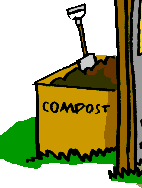You Can Compost Too!
All composting requires three basic ingredients:
- Browns—Includes materials such as dead leaves, branches, twigs
- Greens—Includes materials such as grass clippings, vegetable waste, fruit scraps, and coffee grounds
- Water

Having the right amount of greens, browns, and water is important for compost development. Ideally, your compost pile should have an equal amount of browns to greens and alternate layers of organic waste of different-sizes. The brown materials provide carbon for your compost and the green materials provide nitrogen, while the water provides moisture to help breakdown the organic matter.
One approach to composting:
- Select a dry, shady spot near a water source for your compost pile or bin.
- Add your brown and green materials as you collect them, making sure larger pieces are chopped or shredded.
- Moisten dry materials as they are added.
- Once your compost pile is established, mix grass clippings and green waste into the pile and bury fruit and vegetable waste under 10 inches of compost material.
- Optional: Cover top of compost with a tarp to keep it moist.
- When the material at the bottom is dark and rich in color, your compost is ready to use (this is usually occurs in two months to two years).
If you don't have enough room outside, you can even compost indoors!
You can compost materials indoors using a special type of bin, which you can buy or make yourself. Remember to tend your pile and keep track of what you throw in. A properly managed compost bin will not attract pests or rodents and will not smell bad. Your compost should be ready in 2 to 5 weeks.



